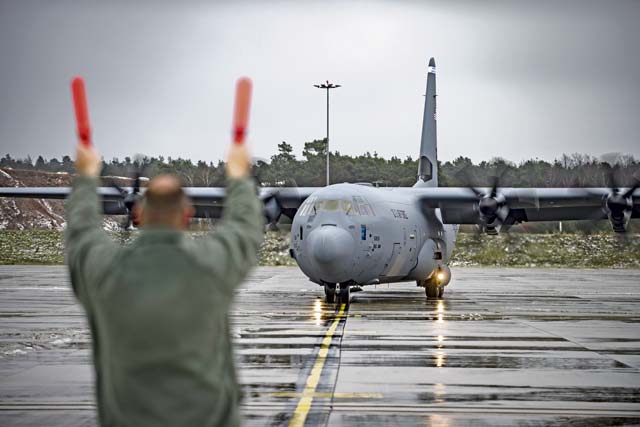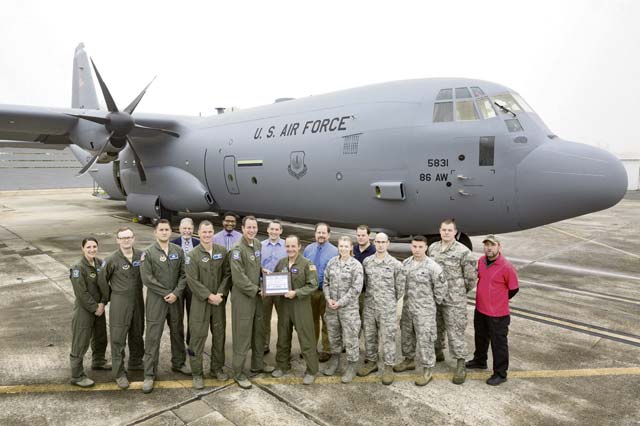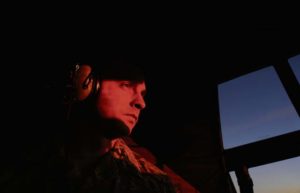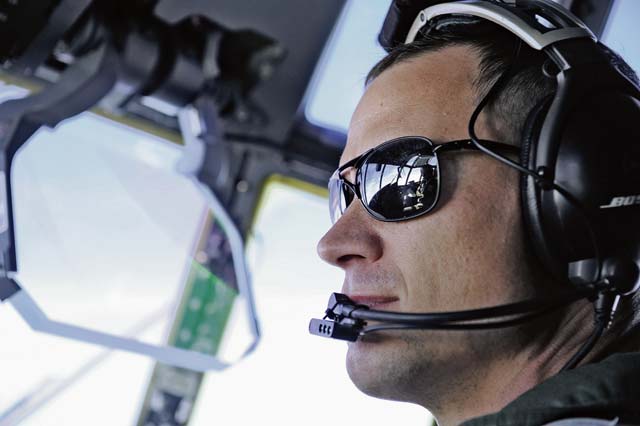
A crew assigned to the 37th Airlift Squadron crossed the Atlantic Ocean to retrieve a brand new C-130J Super Hercules from the Lockheed Martin Aeronautics Company production facility, in Marietta, Georgia, Nov. 29.
The C-130J, an upgraded version of the C-130 Hercules legacy model, adds 15 feet to the fuselage and increases usable space in the cargo compartment. The new aircraft replaces one of 14 C-130Js in Ramstein’s fleet, helping avoid potential problems with the Air Force’s aging fleet.
“I can’t overstate the importance and significance of rebalancing our fleet,” said Col. Joseph Wenckus, 86th Airlift Wing vice commander, “Replacing older aircraft rotationally allows us to balance out the number of older and newer planes in any given location across the C-130J enterprise, which strengthens the force.”
The concept, according to Air Mobility Command, is called “Enterprise Fleet Management” and allows extended aircraft life by rotating aircraft amongst units across the Air Force. Locally, this means the new aircraft will replace a C-130J that will transfer to Yokota Air Base, Japan.

Lockheed Martin Aeronautics Company turns over the keys to the newest C-130J in the 37th Airlift Squadron fleet to the team from Ramstein. Part of a concept, according to Air Mobility Command, called “Enterprise Fleet Management,” the new aircraft replaces a C-130J that was transferred to Yokota Air Base, Japan. — Photo courtesy of Lockheed Martin Aeronautics Company
Due to a challenging operational environment or increased requirements driven by mission demands, there is the potential for the lifespan of these aircraft to be prematurely shortened, said Wenckus.
“With missions, required maintenance, and wear and tear more evenly distributed across all Air Force units, we are able to better maintain Ramstein’s C-130J fleet and guarantee world-class tactical airlift to two combatant commands,” said Wenckus.
According to Lockheed Martin, the aircraft is built on the legacy of the basic C-130 design, however, the C-130J features a large, unobstructed, fully-pressurized cargo hold that can be rapidly reconfigured for carrying troops, stretchers, passengers, or airdrop of troops and equipment into battle zones.
The aircraft also features upgraded avionics, improved lift capacity, superior climb performance, and long-range landing field capabilities.
“The avionics are astronomically better in this aircraft than the older legacy model,” said Maj. Kyle Bucher, 37th AS C-130J pilot. “It has improved performance, it’s faster, burns less fuel, carries more, and requires fewer crew members.”
The versatile aircraft is used across the Air Force for medical evacuation, delivering humanitarian aid, airdropping equipment and personnel, cargo delivery, firefighting, aerial refueling, aerial spray, and arctic support missions.
With continuous production longer than any other military aircraft, the C-130J has earned a reputation as a workhorse ready for any mission, anytime, anywhere.

Master Sgt. Caleb Thorne, 86th Aircraft Maintenance Squadron productions superintendent, watches the sunrise over Shannon, Ireland, from a C-130J Super Hercules, Dec. 4. The crew traveled across three countries and three states within the U.S. in one week to pick-up Ramstein’s new aircraft from Lockheed Martin Aeronautics Company production facility headquarters in Marietta, Georgia.
The 37th AS provides air support to U.S. European Command and U.S. Africa Command, ensuring tactical airlift assets and mission readiness for the theater, said 1st Lt. Jane Marlow, 37th AS C-130J pilot.
“The thing I love the most about the Herc is the mission,” Marlow said. “It’s the sound of home. Whether it’s picking personnel up from deployment, bringing beans and bullets to the troops that need them, or dropping Christmas care packages to deployed locations, I believe the C-130J is the best aircraft in the Air Force.”
The crew traveled across three countries and three states within the U.S. in one week to pick up Ramstein’s new aircraft, having the unique opportunity to tour Lockheed’s warehouse facility at their headquarters in Marietta.
“This mission is one of the things of legend,” Wenckus said. “I’m over the moon, and not only honored but humbled to be a part of such a quintessential element of the Air Force legacy: delivering brand new capability directly to the warfighter.”


First Lt. Melinda Marlow (left), and Maj. Kyle Bucher (right), 37th Airlift Squadron C-130J Super Hercules pilots, fly a C-130J over Shannon, Ireland, during the sunrise, Dec. 4. A crew assigned to the 37th Airlift Squadron crossed the Atlantic Ocean to retrieve a brand new C-130J Super Hercules from the Lockheed Martin Aeronautics Company production facility, in Marietta, Georgia, Nov. 29. — Photo by Airman 1st Class Savannah L. Waters







